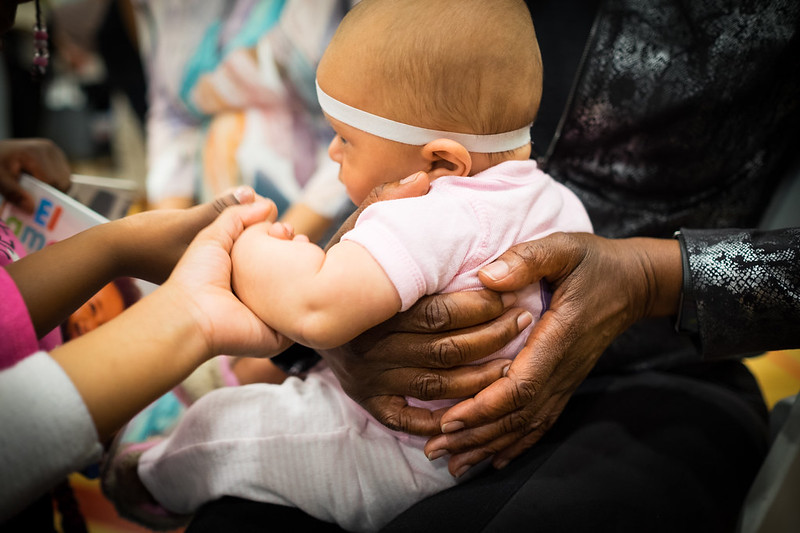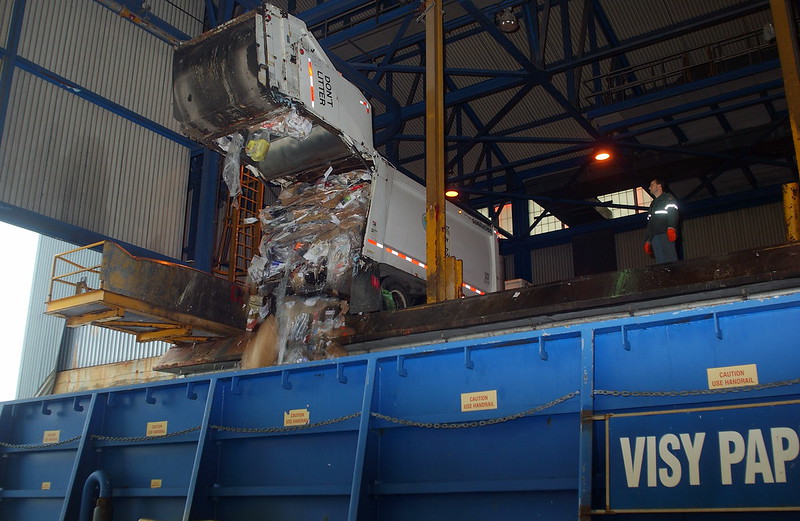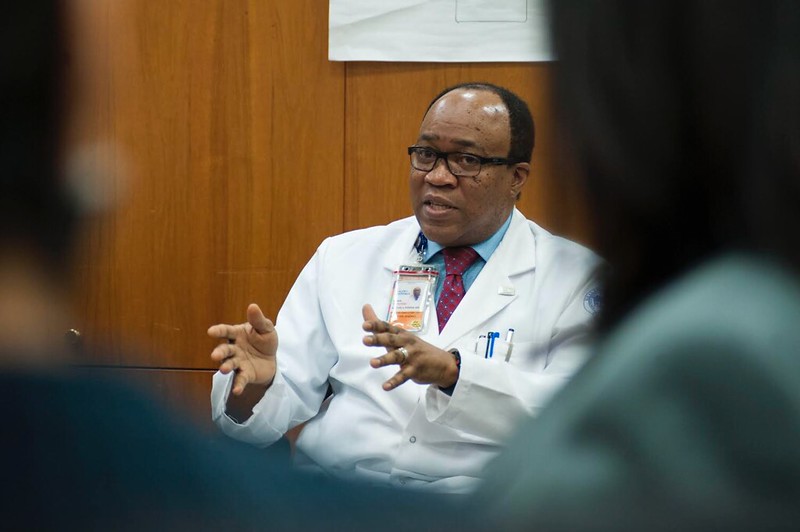Black Mothers Matter: Bringing Justice to Maternity — Now

Deep and deadly health care disparities persist (photo: Edwin J. Torres/Mayor's Office)
In December of 2019, Sha-Asia Washington joyfully announced her pregnancy to her mother. In December of 2018 I had done the same. Throughout the Spring of 2020, she and her boyfriend counted down the days until her June due date. I had done the same in 2019. As she neared her due date, she went into the hospital with high blood pressure. Diagnosed with preeclampsia, I had done the same.
A year later, I’m sitting with my son on the floor. I playfully comb my fingers through his hair as he leans into my chest. But Sha-Asia can’t do the same -- she tragically died in the hospital during an emergency c-section.
Why?
Maternal mortality, the death of a mother from pregnancy-related complications, is a crisis in the United States. While the global maternal mortality rate dropped by 44 percent between 1990 and 2015, the U.S. was one of only 13 countries, including North Korea and Zimbabwe, that saw its rate increase.
In New York it’s even worse. In 2016, New York was ranked 30th in the nation for its maternal mortality rate. Maternal deaths increased from 15.4 deaths per 100,000 live births in 2001-2003 to 19.6 deaths per 100,000 live births in 2014-2016.
Maternal mortality is highly racialized; in New York City, from 2006 to 2010, Black women were 12 times more likely than white women to die from pregnancy-related causes.
Yet over 60 percent of these deaths are preventable, according to the CDC Foundation. In recent years, both New York City and State have announced plans to address these disturbing trends; officials have held press conferences and established committees. And yet mothers like Sha-Asia Washington, Amber Rose Isaacs, and Cordielle Street have all died in New York City this year alone.
The COVID-19 pandemic has only magnified the inequities in our health-care system, made worse by inequities in housing and education, revealing just how dangerous it is to be a pregnant Black woman in our city. We can’t expect to eliminate or even reduce maternal mortality when we don’t guarantee Black and brown mothers the right to clean and safe housing.
Creating a more just and equitable city demands the active dismantling of systemic racism that is ingrained within other social structures that govern our lives, including law enforcement, health care, housing, and education. It also requires the commitment of decision-makers at every level to value the lives of women of color, particularly when they are most vulnerable: pregnancy and childbirth.
Addressing maternal mortality begins with valuing women’s health and increasing access to health care and family planning. It involves ensuring that expectant mothers have access to comprehensive reproductive health care, counseling, and housing. We need more community health centers, assistance for working women to keep their prenatal visits, and to ensure expectant mothers have access to health advocates, such as doulas or social workers, throughout every phase of pregnancy.
Finally, this essential work involves holding our hospitals, government agencies, and elected officials accountable, ensuring implicit bias trainings for all hospital staff and demanding transparency in reporting on frequency, cause, location, and racial breakdown of maternal deaths and major complications that arise in our maternity wards or in the following postpartum months.
Ending this crisis involves all of this and more. It’s also going to take all of us to come together and say no more mothers lost. Black lives matter. Black mothers matter. It’s time we prove it by demanding justice in maternity.
***
Tricia Shimamura is a candidate for New York City Council District 5. On Twitter at @ShimamuraTricia.
***
Have an op-ed idea or submission for Gotham Gazette? Email This email address is being protected from spambots. You need JavaScript enabled to view it.
Wasted Opportunities: New York City’s Misplaced Budget Priorities Fail Marginalized Communities and Us All

Garbage time (photo: Michael Anton/Department of Sanitation)
Unequal impacts of COVID-19 on low-income Black and brown communities have magnified the consequences of our unsustainable working and living processes and accumulated environmental injustices.
The highest rates of pandemic-related deaths are in the same communities that have long breathed more polluted air and who deal day-to-day with heightened police violence. The accelerating climate crisis will amplify both of these forms of violence as the stagnant quality of hot air concentrates local pollution and local governments are predicted to continue responding to climate stressors and survival economics with increased policing. Yet in the face of hundreds of thousands of people mobilizing in the streets following Black leadership to demand New York City’s budget divest from policing and invest in communities, the City Council and Mayor have shown their true colors.
New York City’s new fiscal year 2021 (FY21) budget fails the calls to restructure our society away from carceral systems and toward systems that nourish community safety and wellbeing.
As Black femme and Brown nonbinary organizers fighting for environmental and climate justice in our personal and professional lives, we understand the roots of the climate crisis to be the same as those that have led to COVID-19’s emergence and disproportionate impacts. White supremacy, patriarchy, and capitalism are harmful ideologies that allowed the brutal enslavement and torture of Africans and violent colonization of Indigenous communities globally. Abolition did not dissolve slavery, but transitioned anti-Blackness into the foundation of our current systems.
Today, systems of violence and oppression are rooted in these ideologies and consequently engender the highest burdens and harms to Black, Indigenous femme, transgender, queer, and disabled people. These systems continue to proliferate through racist and classist legislation and budgetary processes that are enabled by military and carceral forces.
In the wake of the pandemic, breaking climate records, and mass calls for systems that affirm the value of Black life, both of our organizations have continued to embody frontline solutions.
Since 1991, New York City Environmental Justice Alliance has worked to rectify the negative impacts of disparate siting of noxious infrastructure in Black and brown communities through research, education, and advocacy, while also working to gird against the intersecting, harmful effects of climate change.
BK ROT is New York City’s first food-waste bike collection and composting service in Bushwick, Brooklyn. Powered by local youth, BK ROT reflects the intimate ties between environmental and social injustices, and the need to center local youth leadership in advancing solutions. During the city’s closing of residential composting options, BK ROT continued to employ youth essential workers to safely collect and process food waste, which reduces local air pollution, improves our lead-burdened soils, and feeds our communities. Furthermore, BK ROT and some NYC-EJA members have joined mutual aid work, including by servicing and supporting food distribution hubs with bike-based deliveries.
The de Blasio administration has acknowledged that the city is far from achieving its waste equity and zero waste goals, but upon strong coercion by Mayor de Blasio the City Council approved a budget for FY21 that eliminates several services essential to community health, while leaving NYPD’s $6 billion budget nearly completely intact. Our communities need resources to thrive and build resilience in the face of worsening crises. It is time we stop investing in harmful systems rooted in white supremacy and invest in regenerative, life-giving systems that nourish and heal our communities and this sacred earth we live upon.
A budget that truly recognized our current crises would have defunded the NYPD and expanded a variety of social and environmental services, including restoring and expanding organics drop-off sites, mandating curbside organics collection, and promoting green jobs and youth employment opportunities that further climate resilience and model regenerative economies (see recommendations for climate and environmental justice investments in our waste system here).
As for legislative and budgetary solutions in the short-term, the proposed CORE Act in the City Council could restore and increase equity in access to organics and textile drop off sites while we continue pushing for more comprehensive organic waste collection citywide. As we await to see how the $2.86 million funding for composting in the FY21 budget is allocated, we will promote resources for composting locally where you can.
When the administration has failed communities, we have seen mutual aid groups rising up to meet the gaps. Until city government aligns its priorities with communities, we must work to create alternatives that model and advance environmental and climate justice. We are inspired by mutual aid food distribution hubs, like University Settlement and Mayday Space, community free fridges, and the rise of grassroots food scraps drop-off sites.
From the individual to the community level we must shape change, while movements put pressure on systems of governance for them to catch up. It is critical that we take decisive action towards a better future and divest from the root causes of current crises that replicate harms in our communities.
***
Ceci Pineda is Executive Director of BK ROT and Tok Michelle Oyewole, Ph.D., is Policy & Communications Organizer at the New York City Environmental Justice Alliance. On Twitter @iamceci & @_DrTok.
***
Have an op-ed idea or submission for Gotham Gazette? Email This email address is being protected from spambots. You need JavaScript enabled to view it.
Telehealth is Helping New York Tackle Our Mental Health Crisis, But It Must Be Funded

Health care by video has increased in importance (photo: Jeff Reed/City Council)
When we first met Alice two years ago, she suffered from schizophrenia, depression, uncontrolled diabetes, hypertension, and high cholesterol. Even though we set up pill boxes for her and arranged home health aides, she chose to seek treatment only in emergency rooms. Her health continued to deteriorate.
Last year, Alice finally began to engage in treatment for her diabetes by phone, but her nurse practitioner provided this treatment on her own time, without government funding. Alice’s serious health problems put her squarely in the high-need, high-cost category of patients who demand innovative treatment approaches. But our 20th century regulatory system held her back.
Ironically, the COVID-19 epidemic changed things. By necessity, Alice was offered more care by telephone and videoconference. She was able to accept these offers, and began following up with her appointments. This only became possible because emergency orders issued by Governor Cuomo allowed the state to reimburse health-care providers for telehealth services as if they were in-office visits, while suspending bureaucratic rules that made it hard for providers to offer telehealth services in the first place.
The pandemic will end someday. But treating our clients with serious mental illness — many of whom, like Alice, also have debilitating physical issues — by telephone and video conference has proven to be an unexpected success. We need to take advantage of this crisis and bring our laws into the 21st century.
At the Institute for Community Living, which provides care to people living with a range of mental health issues, a survey of almost 1,500 clients showed high satisfaction with telehealth. Many of them prefer it to visiting a clinic, and 80% said they wanted to continue remote appointments after the pandemic ends.
Telehealth is convenient for people with multiple health problems, and it’s helping clients get better. From March to May, the percentage of clients who failed to keep medical appointments dropped from 33% to just 15%. Using telehealth has allowed us to triage health issues in our residences immediately, rather than requiring clients – accompanied by two staff – to travel to their appointments. This has helped to reduce costly emergency room visits.
None of this would have been possible in February. Prior to the pandemic, we could only bill for telehealth at a fraction of the rate for in-person services. And outdated rules, such as a requirement that both the patient and the physician be physically located in a licensed facility, meant that only a fraction of patients could actually benefit from telehealth services.
COVID-19 has put tremendous stress on our health and mental health systems. The pandemic itself and the subsequent economic fallout are causing widespread and profound distress that could lead to a lasting mental health crisis. It has also put New Yorkers who were already struggling with severe mental health conditions at even higher risk.
The emergency orders have been extended short-term by the governor and the Legislature should act to make them permanent. State Senator Peter Harckham and Assembly Members Linda Rosenthal and Aileen Gunther have introduced legislation that would allow telehealth sessions to be reimbursed at the same rate as in-person visits, and Harckham and Rosenthal introduced separate bills that would expand eligibility for telehealth. When the Legislature next reconvenes, we hope these bills can be passed quickly and signed into law, enabling organizations to better serve New Yorkers living with mental health issues and meet the mental health challenges caused COVID-19.
This pandemic has shown us that technology can be used to connect people remotely in ways we didn’t think were possible. Millions of Americans are now working from home just as productively as they were at a desk in an office prior to COVID-19, with companies like Twitter changing their policies to allow employees to work remotely full-time. There is no reason our regulations can’t allow us to use this technology to better provide life-saving health-care services to New Yorkers like Alice.
***
David Woodlock is the president and CEO of the Institute for Community Living. He is a former deputy commissioner at the New York State Office of Mental Health.
***
Have an op-ed idea or submission for Gotham Gazette? Email This email address is being protected from spambots. You need JavaScript enabled to view it.




